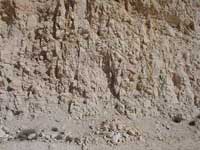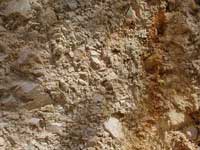| A few kilometers outside the northern ring of the Azuara impact structure near Belchite, a handful of isolated large blocks of Jurassic limestones emerge from the post-impact Upper Tertiary Ebro basin sediments. Quarrying in these blocks has enabled instructive insight into the drastic impact deformations experienced by very large rock volumes. | |
 A A |
 B B |
| Image A shows part of a large quarry located at UTM coordinates 0687000, 4583000. The visible length in the image is roughly 300 m. The limestones are drastically destroyed through and through to form a more or less continuous breccia displaying grit (gries) brecciation and mortar texture (see Images B – E). |  C C |
 D D |
 E E |
| Comparable strong and continuous deformations (Images F, G) can be observed in a limestone quarry located in another block at UTM coordinates 0683000, 4583000. | |
 F F |
 G G |
| H and I Ries impact structure; Iggenhausen quarry | |
 H H |
 I I |
| Comment: The Azuara region and the Jurassic limestones underwent Alpidic tectonics with some folding and block faulting, but we emphasize that Alpidic tectonics can not possibly have caused these disastrous deformations over hundreds of meters. Impact cratering is the only reasonable process to have produced this impressive geologic scenario, and the same deformations are well known to occur in large allochthonous limestone megablocks ejected from the 25km-diameter Ries impact structure (Germany) (Images H, J; Iggenhausen quarry).We suggest that those geologists from the Zaragoza university and the Center of Astrobiology (Madrid) vehemently refusing an Azuara impact visit these highlighting outcrops. Since they like to contrast the Azuara structure with the Ries crater (see their MAPS paper referred to in the Controversy section), they will get a lot of illustrative material.There is one more point we want to refer to. As already said, impact is the only reasonable geologic process that explains these desastrous and voluminous deformations. In other words, there’s actually no need for the well documented strong shock effects in Azuara polymictic breccias to establish Azuara as an impact structure (see below in the Archives and https://www.impact-structures.com/impact-spain/the-azuara-impact-structure/shock-effects-shock-metamorphism-in-rocks-from-the-azuara-impact-structure/ ). The outcrops under discussion here are as well a convincing proof.Usually, the impact nature of a structure under discussion is established by the occurrence of shock metamorphism. Reasonably, it is argued that there are no endogenetic processes known to produce, e.g., diaplectic glass or planar deformation features (PDFs) in quartz. Likewise, we argue that there are no endogenetic geologic processes known to have catastrophically destroyed the Jurassic limestones near Belchite.Therefore, geologists should be aware of their competence to establish in some cases an impact structure from pure field evidence. The time has come to give up the very limited point of view of some impact researchers that TEM analyses of PDFs or geochemical signature of the projectile are the ultimate requirement for establishing an impact structure. |
|
Skip to content
ERNSTSON CLAUDIN IMPACT STRUCTURES – METEORITE CRATERS
Research on impact geology, geophysics, petrology, and impact cratering






































































